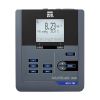Thermo Orion Lab Star DO113 DO Bench Meters
Features
- Budget-friendly meter for simplified dissolved oxygen testing
- Large 5” backlit display makes viewing measurements easy
- Small meter footprint saves valuable lab bench space
- Free ground shipping
- Expedited repair and warranty service
- Lifetime technical support
- More
Overview
The Thermo Scientific Orion Lab Star DO113 Dissolved Oxygen Bench Meter is ideally suited for laboratories with users of varying levels of technical expertise and who require a simple-to-calibrate and use meter for routine dissolved oxygen testing. Simultaneously measures dissolved oxygen as percent saturation, concentration in mg/L or concentration in ppm with temperature.
Ranges
To enable comprehensive measurement capabilities, measure dissolved oxygen in a range of 0.0 to 300.0 % saturation, 0.00 to 30.0 mg/L or ppm and measure temperature in a range of -5.0 to 105.0 °C or 23.0 to 221.0 °F.
Mechanics
For proficient SOP compliance, perform 100% saturation, 0% saturation and custom concentration calibrations for dissolved and one-point temperature adjustment calibrations. View active dissolved oxygen and temperature calibration logs with date and time stamps to ensure accurate, reproducible measurements. Record key measurements using the 500-point data log with date and time stamp. Output data logs and calibration logs to a printer or computer for long-term data storage.
Benefits
Featuring a large, backlit display for easy viewability and a small footprint to save bench space, this dissolved oxygen meter is ideally suited for simplified, budget-friendly lab testing. Use the onscreen stabilizing and ready indicators to help identify when DO meter readings are complete.
LSTAR1130:
- Meter
- Electrode stand
- Computer cable
- Universal power adapter
LSTAR1135:
- Meter
- Electrode stand
- Computer cable
- Universal power adapter
- Polarographic DO/ATC probe with calibration sleeve (Cat. No. 083005MD)
- DO probe maintenance kit (Cat. No. 080513)
- BOD adapter (Cat. No. 080360)
In The News
Combating Water Insecurity in Saskatchewan with Real-Time Data
The prairies of Saskatchewan can be described as one of the least water-secure parts of Canada, making water quality monitoring essential for informed resource management in a region already facing water insecurity. While natural physical properties worsen some of the poor water quality conditions in the region, others are connected to land use. Having grown up spending summers on the shores of Lake Huron, Helen Baulch, an associate professor at the School of Environment and Sustainability at the University of Saskatchewan , has always been dedicated to the protection of water resources. Looking back fondly at her childhood playing along the shore, Baulch also recalls the invasion of quagga mussels during her teenage years and watching the lake change as a result.
Read MoreSeametrics Turbo Turbidity Logger: Boost your Turbidity Monitoring
The Seametrics Turbo Turbidity Logger is a self-cleaning turbidity sensor capable of internally logging over 260,000 data records. The sensor enables researchers, compliance officers, and contractors to monitor turbidity in various applications, from construction and dredging sites to wastewater effluent. Due to its narrow width, this device can be deployed in a range of areas, from small well spaces to rivers and streams. The stainless steel housing and built-in wiper allow the sensor to withstand long-term deployments and reduce the need for maintenance trips. The logger accurately records temperature and turbidity up to a depth of 50 meters.
Read MoreCollecting Data at the Top of the World: How Scientists Retrieve Glacial Ice Cores
A helicopter touches down in the small town of Sicuani, Peru, at an elevation of 11,644 feet. Earlier that day, a boxcar brought fuel, drills, food, and other equipment for a glacial expedition. The year is 1979, and glaciologist Lonnie Thompson is preparing to lead a team to the Quelccaya ice cap in hopes of becoming the first scientists to drill an ice core sample from this glacier. The only problem? The glacier is located at 19,000 feet in one of the most remote areas of the world. The helicopter takes off from the town, but the thin atmosphere at that elevation does not allow it to safely touch down on the ice– due to the aircraft’s weight, and it becomes unstable when the air is less dense.
Read More






















